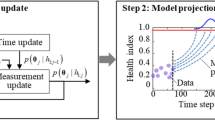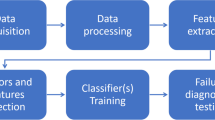Abstract
Condition monitoring (CM) data should undergo through preprocessing to extract health indicators (HIs) for proper system health assessment. Machine health indicators provide vital information about health state of subcomponents(s) or overall system. There are many techniques in the literature used to construct HIs from CM data either for failure diagnostics or prognostics purposes. The majority of proposed HI extraction methods are mostly application specific (e.g. gearbox, shafts, and bearings etc.). This paper provides an overview of the used techniques and proposes an HI extraction, evaluation, and selection framework for monitoring of different applications. The extracted HIs are evaluated through a compatibility test where they can be used in either failure diagnostics or prognostics. An HI selection is carried out by a new hybrid feature goodness ranking metric in feature evaluation. The selected features are then used in fusion to get the representative component HI. Several case study CM data are used to demonstrate the essentiality of the proposed framework in component monitoring.




















Similar content being viewed by others
References
Gouriveau, R., Medjaher, K., Zerhouni, N. (2016). From prognostics and health management to predictive maintenance. ISTE - Wiley.
Atamuradov, V., Medjaher, K., Dersin, P., Lamoureux, B., & Zerhouni, N. (2017). Prognostics and health management for maintenance practitioners – Review, implementation and tools evaluation. International Journal of Prognostics and Health Management, 8 (Special Issue on Railways & Mass Transportation) 060, pages: 31, ISSN 2153-2648.
Atamuradov, V., Medjaher K., Camci, F., Dersin, P., & Zerhouni, N. (2018). Railway point machine prognostics based on feature fusion and health state assessment. IEEE Transactions on Instrumentation and Measurement, Article in Press, https://doi.org/10.1109/TIM.2018.2869193.
Liu, D., Zhou, J., Liao, H., Peng, Y., & Peng, X. (2015). A health indicator extraction and optimization framework for lithium-ion battery degradation modeling and prognostics. IEEE Transactions on Systems, Man, and Cybernetics: Systems, 45(6), 915–928.
Atamuradov, V., & Camci, F. (2017). Segmentation based feature evaluation and fusion for prognostics feature selection based on segment evaluation. The International Journal of Prognostics and Health Management, 8, 1–14.
Zhu, J., Nostrand, T., Spiegel, C., & Morton, B. (2014). Survey of condition indicators for condition monitoring systems. Annual Conference of the Prognostics and Health Management Society, 5, 1–13.
Sait, A. S. (2011). A review of gearbox condition monitoring based on vibration analysis techniques diagnostics and prognostics. Rotating Machinery, Structural Health Monitoring, Shock and Vibration, 5, 307–324.
Sharma, V., & Parey, A. (2016). A review of gear fault diagnosis using various condition indicators. Procedia Engineering, 144, 253–263.
Lebold, M., Mcclintic, K., Campbell, R., Byington, C., & Maynard, K. (2000). Review of vibration analysis methods for gearbox diagnostics and prognostics. In 54th meeting of the society for machinery failure prevention technology (pp. 623–634).
Soualhi, A., Medjaher, K., & Zerhouni, N. (2015). Bearing health monitoring based on Hilbert – Huang ransform, support vector machine, and regression. IEEE Transactions on Instrumentation and Measurement, 64(1), 52–62.
Al-atat, H., Siegel, D., & Lee, J. (2011). A systematic methodology for gearbox health assessment and fault classification. The International Journal of Prognostics and Health Management, (February), 1–16.
Li, L., Ming, T., Liu, S., & Zhang, S. (Apr. 2017). An effective health indicator based on two dimensional hidden Markov model. Journal of Mechanical Science and Technology, 31(4), 1543–1550.
Si, J., Li, Y., & Si, J. (2018). Intelligent fault diagnosis for industrial big data. Journal of Signal Processing Systems.
Bennouna, O., & Roux, J. P. (2013). Real time diagnosis & fault detection for the reliability improvement of the embedded systems. Journal of Signal Processing Systems, 73(2), 153–160.
Shi, W., Zhu, Y., Huang, T., Sheng, G., Lian, Y., Wang, G., & Chen, Y. (2017). An integrated data preprocessing framework based on apache spark for fault diagnosis of power grid equipment. Journal of Signal Processing Systems, 86(2–3), 221–236.
Tamilselvan, P., Wang, P., Sheng, S., & Twomey, J. M. (2013). A two-stage diagnosis framework for wind turbine gearbox condition monitoring. The International Journal of Prognostics and Health Management, Special Issue on Wind Turbines PHM.
Rai, A., & Upadhyay, S. H. (2016). A review on signal processing techniques utilized in the fault diagnosis of rolling element bearings. Tribology International, 96, 289–306.
Tobon-Mejia, D. A., Medjaher, K., Zerhouni, N., & Tripot, G. (2012). A data-driven failure prognostics method based on mixture of Gaussian hidden Markov models. IEEE Transactions on Reliability, 61(2), 491–503.
Ben Ali, J., Saidi, L., Mouelhi, A., Chebel-Morello, B., & Fnaiech, F. (2015). Linear feature selection and classification using PNN and SFAM neural networks for a nearly online diagnosis of bearing naturally progressing degradations. Engineering Applications of Artificial Intelligence, 42, 67–81.
Firpi, H., & Vachtsevanos, G. (2008). Genetically programmed-based artificial features extraction applied to fault detection. Engineering Applications of Artificial Intelligence, 21(4), 558–568.
Benkedjouh, T., Medjaher, K., Zerhouni, N., & Rechak, S. (2013). Remaining useful life estimation based on nonlinear feature reduction and support vector regression. Engineering Applications of Artificial Intelligence, 26(7), 1751–1760.
Camci, F., Medjaher, K., Zerhouni, N., & Nectoux, P. (2013). Feature evaluation for effective bearing prognostics. Quality and Reliability Engineering International, 29(4), 477–486.
Lei, Y., Li, N., Guo, L., Li, N., Yan, T., & Lin, J. (2018). Machinery health prognostics: A systematic review from data acquisition to RUL prediction. Mechanical Systems and Signal Processing, 104(May), 799–834.
Liao, L. (2014). Discovering prognostic features using genetic programming in remaining useful life prediction. IEEE Transactions on Industrial Electronics, 61(5), 2464–2472.
Coble, J., & Hines, J. W. (2009). Identifying optimal prognostic parameters from data: A genetic algorithms approach. Proceedings of Annual Conference of the Prognostics and Health Management Society, 1–11.
Zhang, B., Zhang, L., & Xu, J. (2015). Degradation feature selection for remaining useful life prediction of rolling element bearings. Quality and Reliability Engineering International, No. February 2015, p. n/a-n/a.
Wang, D., Tse, P. W., Guo, W., & Miao, Q. (2011). Support vector data description for fusion of multiple health indicators for enhancing gearbox fault diagnosis and prognosis. Measurement Science and Technology, 22(2), 25102.
Guo, L., Li, N., Jia, F., Lei, Y., & Lin, J. (2017). A recurrent neural network based health indicator for remaining useful life prediction of bearings. Neurocomputing, 240, 98–109.
Niu, G., & Yang, B. S. (2010). Intelligent condition monitoring and prognostics system based on data-fusion strategy. Expert Systems with Applications, 37(12), 8831–8840.
Liu, J., Zhang, M., Zuo, H., & Xie, J. (2014). Remaining useful life prognostics for aeroengine based on superstatistics and information fusion. Chinese Journal of Aeronautics, 27(5), 1086–1096.
Liu, D., Peng, Y., Li, J., & Peng, X. (2013). Multiple optimized online support vector regression for adaptive time series prediction. Measurement, 46(8), 2391–2404.
Williard, N., He, W., Osterman, M., & Pecht, M. (2013). Comparative analysis of features for determining state of health in lithium-ion batteries. International Journal of Health Policy and Management, 2013(4), 1–7.
Jardine, A. K. S., Lin, D., & Banjevic, D. (2006). A review on machinery diagnostics and prognostics implementing condition-based maintenance. Mechanical Systems and Signal Processing, 20(7), 1483–1510.
Večeř, P., Kreidl, M., & Šmíd, R. (2005). Condition indicators for gearbox condition monitoring systems. Acta Polytechnica, 45(6), 35–43.
Zakarjsek, J. J., Townsend, D. P., & Decker, H. J. (1993). An analysis of gear fault detection methods as applied to pitting. Nasa Tm-105950 Avscom Tr-92-C-035, 13.
Decker, H. J., Handschuh, R. F., & Zakrajsek, J. J. (1994). An enhancement to the NA4 gear vibration diagnostic parameter. Nasa Tm-106553 Arl-Tr-389, 1994, 20.
Antoni, J., & Randall, R. B. (2006). The spectral kurtosis: Application to the vibratory surveillance and diagnostics of rotating machines. Mechanical Systems and Signal Processing, 20(2), 308–331.
Huang, N., Shen, Z., Long, S., Wu, M., SHIH, H., ZHENG, Q., Yen, N., Tung, C., & Liu, H. (1998). The empirical mode decomposition and the Hilbert spectrum for nonlinear and non-stationary time series analysis. Proceedings of the Royal Society A: Mathematical, Physical and Engineering Sciences, 454(1971), 995.
Singh, S., & Kumar, N. (2014). Combined rotor fault diagnosis in rotating machinery using empirical mode decomposition. Journal of Mechanical Science and Technology, 28(12), 4869–4876.
Gebraeel, N., Elwany, A., & Pan, J. (2009). Residual life predictions in the absence of prior degradation knowledge. IEEE Transactions on Reliability, 58(1), 106–117.
Camci, F., Eker, O. F., Baskan, S., & Konur, S. (2016). Comparison of sensors and methodologies for effective prognostics on railway turnout systems. Proceedings of the Institution of Mechanical Engineers, Part F: Journal of Rail and Rapid Transit, 230(1), 24–42.
Chaoui, H., Golbon, N., Hmouz, I., Souissi, R., & Tahar, S. (2015). Lyapunov-based adaptive state of charge and state of health estimation for lithium-ion batteries. IEEE Transactions on Industrial Electronics, 62(3), 1610–1618.
Camci, F., Ozkurt, C., Toker, O., & Atamuradov, V. (2015). Sampling based state of health estimation methodology for Li-ion batteries. Journal of Power Sources, 278, 668–674.
Acuña, D. E., & Orchard, M. E. (2017). Particle-filtering-based failure prognosis via sigma-points: Application to lithium-ion battery state-of-charge monitoring. Mechanical Systems and Signal Processing, 85, 827–848.
Orchard, M. E., Hevia-Koch, P., Zhang, B., & Tang, L. (2013). Risk measures for particle-filtering-based state-of-charge prognosis in lithium-ion batteries. IEEE Transactions on Industrial Electronics, 60(11), 5260–5269.
Li, H., Pan, D., & Chen, C. L. P. (2014). Intelligent prognostics for battery health monitoring using the mean entropy and relevance vector machine. IEEE Transactions on Systems, Man, and Cybernetics: Systems, 44(7), 851–862.
Wang, D., Miao, Q., & Pecht, M. (2013). Prognostics of lithium-ion batteries based on relevance vectors and a conditional three-parameter capacity degradation model. Journal of Power Sources, 239, 253–264.
Henao, H., Kia, S. H., & Capolino, G. A. (2011). Torsional-vibration assessment and gear-fault diagnosis in railway traction system. IEEE Transactions on Industrial Electronics, 58(5), 1707–1717.
Morgado, T. L. M., Branco, C. M., & Infante, V. (2008). A failure study of housing of the gearboxes of series 2600 locomotives of the Portuguese railway company. Engineering Failure Analysis, 15(1–2), 154–164.
Zhang, B., Tan, A. C. C., & Lin, J. H. (2016). Gearbox fault diagnosis of high-speed railway train. Engineering Failure Analysis, 66, 407–420.
Acknowledgments
This research was supported by a grant from ENIT, Production Engineering Laboratory (LGP), funded by ALSTOM. Gearbox condition monitoring data were provided by the ALSTOM. Point machine and Li-ion degradation datasets were taken from the projects (#108 M275 and #113 M093), which were supported by The Scientific and Technological Research Council of Turkey (TUBITAK).
Author information
Authors and Affiliations
Corresponding author
Additional information
Publisher’s Note
Springer Nature remains neutral with regard to jurisdictional claims in published maps and institutional affiliations.
Rights and permissions
About this article
Cite this article
Atamuradov, V., Medjaher, K., Camci, F. et al. Machine Health Indicator Construction Framework for Failure Diagnostics and Prognostics. J Sign Process Syst 92, 591–609 (2020). https://doi.org/10.1007/s11265-019-01491-4
Received:
Revised:
Accepted:
Published:
Issue Date:
DOI: https://doi.org/10.1007/s11265-019-01491-4




